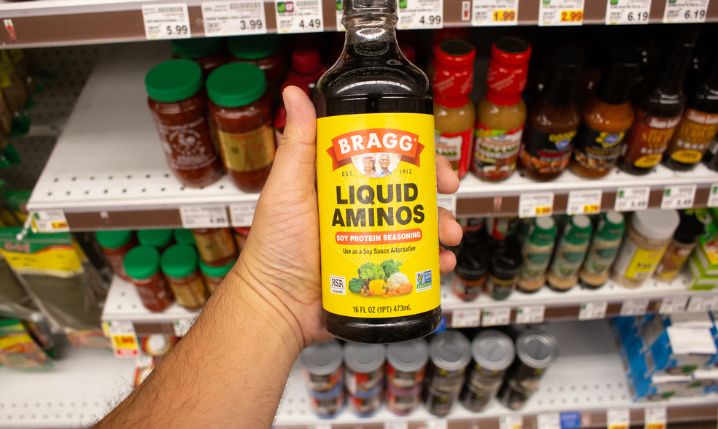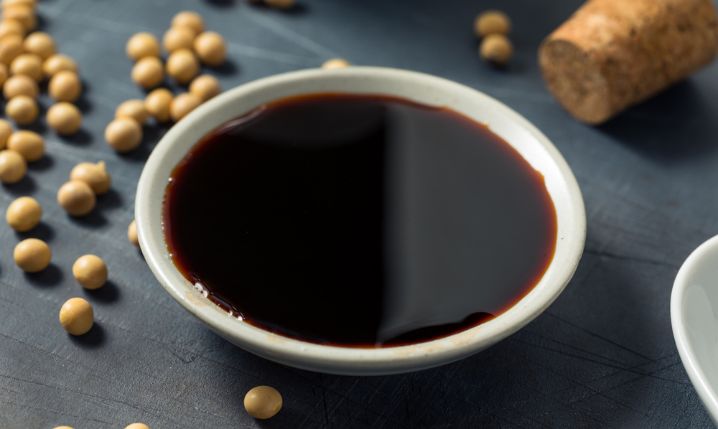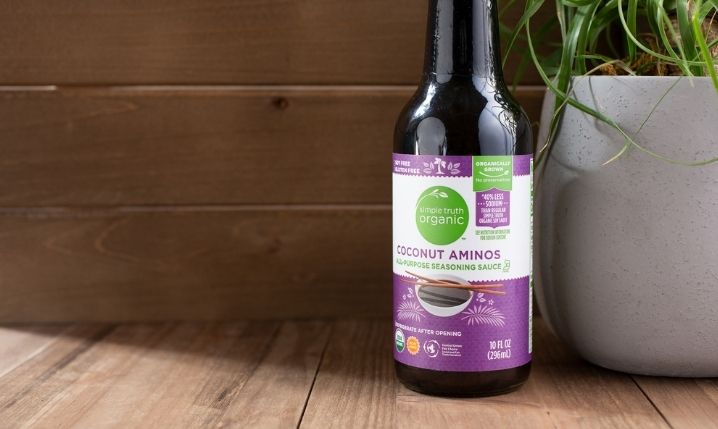Liquid Aminos is a seasoning sauce product produced by Bragg. They are made with soybeans and purified water. Bragg Liquid Aminos is known as a healthier alternative to soy sauce. This article looks at some of the best liquid aminos substitute options for any situation.
Contents:
What Are Liquid Aminos?

Bragg Liquid Aminos are made with soybeans and purified water. They are often used as an alternative to soy sauce and similar sauces like tamari.
The sauce is a rich dark brown and tastes similar to regular soy sauce, providing the same umami flavor without the same intense level of saltiness. Liquid aminos are also a bit sweeter than some other soybean-based sauces.
In terms of consistency, liquid aminos are similar to soy sauce with a medium-watery viscosity.
Liquid Aminos are noted for being gluten-free, MSG-free, and vegan-friendly. Bragg’s Liquid Aminos is also made with certified GMO-free soybeans.
You can use liquid aminos for seasoning meat and vegetables; it works well in stir-fries but can also be used as a regular condiment or dipping sauce for dumplings, sushi, and similar foods. They are also sometimes used for salad dressings.
Substitutes For Liquid Aminos
Suppose you require another option for health reasons or something that simply tastes as similar as possible. In that case, there are a few excellent options that work as a substitution for liquid aminos in any situation.
| Substitute | Taste | Good For |
|---|---|---|
| Tamari | Umami, Mildly Sweet | Sushi, Sashimi, Stir-fries, Noodles, Veggies, Meat |
| Coconut Aminos | Salty, Sweet, Umami | Stir-fries, Soups, Veggies, Chicken, Noodles |
| Soy Sauce | Salty, Sharp, Umami | Noodles, Soups, Sushi, Stir-fries, Chicken, Pork |
1. Tamari

Tamari is a Japanese variation of Chinese soy sauce. It’s made by pressing the paste of fermented soybeans to gather the liquid, making tamari sauce.
Unlike liquid aminos, tamari has a thicker consistency, making it better as a dipping sauce or marinade. However, it still works for stir-fries, noodles, rice, and other similar dishes containing those staple ingredients in Asian cuisine.
Another reason that tamari makes a great alternative for liquid aminos is that they are also gluten-free and MSG-free.
They are most similar in that they have a similar overall appearance and an umami flavor, which adds that savory flavor to dishes without the same level of saltiness as you get with soy sauce.
All that being said, one big difference is that tamari has a more intense, rich flavor, which means that you might want to dilute it a little before making it a 1:1 replacement if you prefer the less-intense taste of liquid aminos.
2. Coconut Aminos

Coconut aminos are often cited as being similar and completely interchangeable with liquid aminos, but that’s not always the case.
While both make great substitutes for one another, it’s best to remember that they have different overall tastes. Liquid aminos aren’t as salty as coconut aminos and are also not quite as sweet.
In terms of consistency, they’re similar, meaning you can use coconut aminos as a substitute for liquid aminos on dressings, dipping sauces, and general condiments. Coconut aminos also make an excellent option for veggies, stir-fries, and as a marinade for meat.
One of the biggest reasons that coconut aminos make an excellent alternative to liquid aminos is that they are soy-free, perfect for anyone with soy allergies or intolerances. Like liquid aminos, they are also free of MSG (Monosodium Glutamate) and Gluten.
Another thing to remember is that coconut aminos do not actually taste like coconut because they’re made from fermented coconut-blossom nectar.
3. Soy Sauce

Soy sauce and liquid aminos are often used interchangeably for one another for several important reasons.
The first thing that you should know is that they have a similar appearance and consistency. The liquid of these sauces isn’t too viscous (thick).
Soy sauce has a similar overall taste and flavor to liquid aminos, with the savory taste coming from the fermented soybeans, which gives them that umami flavor.
However, soy sauce contains additional ingredients, including grains. The combination of ingredients in soy sauce means that, unlike liquid aminos, it’s not gluten-friendly and does contain MSG. Liquid aminos also contain a lower salt content, which is something to consider if you’re on a low-sodium diet.
You can substitute liquid aminos for soy sauce in almost any recipe, with it making a good 1:1 replacement if you don’t have any dietary requirements to consider.
Conclusion
Liquid Aminos is an excellent alternative to other soy-based sauces. However, sometimes, you might need a liquid aminos substitute instead. Whether you go for something healthy like coconut aminos or something with the versatility of tamari, there’s an option for you in the list above.
More about Liquid Aminos: